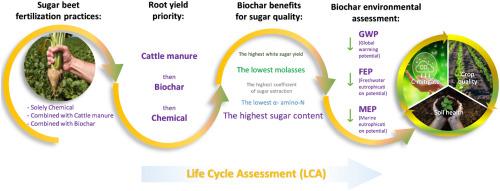Life cycle assessment of biochar and cattle manure application in sugar beet cultivation – Insights into root yields, white sugar quality, environmental aspects in field and factory phases
IF 10
1区 环境科学与生态学
Q1 ENGINEERING, ENVIRONMENTAL
引用次数: 0
Abstract
Sugar beet (Beta vulgaris L.) is a well-known sugar crop essential for supplying the global demand for sugar. Examining how different farming techniques affect the environment may help produce a high-quality crop with the least negative environmental effects. To this, the life cycle assessment (LCA) of biochar (B) and cattle manure (CM) applications at three different rates (5, 10, and 15 tons ha−1) compared with conventional chemical fertilization (CH) in the autumn and spring sugar beet crops has been studied. The system boundaries for LCA analysis were set from the cradle to the sugar factory gate. Based on the results, the highest amounts of root yield were obtained under CM10 and CM15 treatments with 24.5% and 23.2% increase in autumn cultivation and 34.8%, and 33.9% increase in spring cultivation, compared to CH. However, CM15 resulted in significantly lower sugar content (10.9%) than B5 (17%). Also, B utilization significantly reduced molasses content in sugar beet rather than CM in both cultivation periods. Further, biochar treatments (B5, B10, B15) significantly increased the white sugar yield in both cultivation times by 43.7%, 39.2%, and 36.1%, on average. Generally, the highest and the lowest global warming potential (GWP) were obtained from CM15 and B15 with 638.5 and 437.2 CO2-eq ton−1 root/sugar yields, respectively. These findings validate the hypothesis that using biochar in sugar beet production could reduce greenhouse gas emissions while increasing the amount of white sugar produced.

在甜菜种植中施用生物炭和牛粪的生命周期评估--洞察根产量、白糖质量、田间和工厂阶段的环境问题
甜菜(Beta vulgaris L.)是一种著名的糖料作物,对满足全球糖料需求至关重要。研究不同耕作技术对环境的影响有助于生产出对环境负面影响最小的优质作物。为此,研究人员对秋季和春季甜菜作物施用生物炭(B)和牛粪(CM)的三种不同比例(5 吨、10 吨和 15 吨/公顷)与传统化学肥料(CH)进行了生命周期评估(LCA)比较。生命周期评估分析的系统边界设定为从摇篮到糖厂大门。结果表明,与 CH 相比,CM10 和 CM15 处理的根产量最高,秋季栽培分别增加 24.5% 和 23.2%,春季栽培分别增加 34.8% 和 33.9%。但是,CM15 的含糖量(10.9%)明显低于 B5(17%)。此外,在两个栽培期,B 的利用都比 CM 明显降低了甜菜中的糖蜜含量。此外,生物炭处理(B5、B10、B15)在两个栽培期都显著提高了白糖产量,平均增幅分别为 43.7%、39.2% 和 36.1%。一般来说,CM15 和 B15 的全球升温潜能值(GWP)最高和最低,分别为 638.5 和 437.2 CO2-eq ton-1 根/糖产量。这些发现验证了在甜菜生产中使用生物炭可以在增加白糖产量的同时减少温室气体排放的假设。
本文章由计算机程序翻译,如有差异,请以英文原文为准。
求助全文
约1分钟内获得全文
求助全文
来源期刊

Journal of Cleaner Production
环境科学-工程:环境
CiteScore
20.40
自引率
9.00%
发文量
4720
审稿时长
111 days
期刊介绍:
The Journal of Cleaner Production is an international, transdisciplinary journal that addresses and discusses theoretical and practical Cleaner Production, Environmental, and Sustainability issues. It aims to help societies become more sustainable by focusing on the concept of 'Cleaner Production', which aims at preventing waste production and increasing efficiencies in energy, water, resources, and human capital use. The journal serves as a platform for corporations, governments, education institutions, regions, and societies to engage in discussions and research related to Cleaner Production, environmental, and sustainability practices.
 求助内容:
求助内容: 应助结果提醒方式:
应助结果提醒方式:


